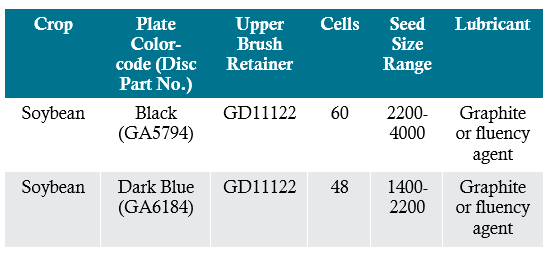Summary
- Soybean seed for the 2021 planting season is larger than normal, with some seed lots being in the 1800-1900 seeds per pound range.
- With appropriate planter adjustments, excellent planting accuracy and stands can be achieved with larger seed.
- In addition to planter adjustments, it is critical to not exceed the planter manufacturer’s recommendations for ground speed.
Soybean Seed Size
Soybean seed size is influenced by both genetics and the environment. Under similar growing conditions, varieties will differ from each other in the seed size they produce - small, medium, or large. Genetic effects on size of seed are largely predictable but weather conditions and their effects on seed size are not.
In 2020, the growing season in Eastern Canada was dry early with significant rainfall and lush growing conditions in August. These conditions caused seed number to be reduced and average seed size to be increased. However, with appropriate planter adjustments, excellent planting accuracy and stands can be achieved with larger seed.
This fact sheet offers management tips to help growers maximize planter performance and ensure the highest possible planting accuracy with larger soybean seed. Refer to your planter manufacturer’s owner’s manual for complete recommendations.
Seed Delivery
Central Commodity System (CCS™), Bulk Fill or Air Seed Delivery (ASD) planter systems may be challenged with larger seed as well as treated seed. To help ensure a high level of performance, proper attention must be given to:
- Seed Flow Lubricants: The liberal use of seed flow lubricant is critical. When using the Bayer Fluency Agent it is critical to mix the fluency agent very thoroughly in the seed.
- Planter Lubricants: Talc or graphite can be used with a mechanical planting system (not air assisted like a soybean brush metering system) and requires graphite to lubricate the planting mechanism.
- Seed Treatment: The planter performance of untreated versus treated seed may be different. Generally, larger seed combined with treatment will require a higher level of management. Tank pressure, fan speeds and other adjustments should be made for the specific seed/ treatment combination that is being planted. Refer to the planter operator’s manual for recommendations.
- Ground Speed: High population settings, especially when combined with high ground speed, may provide challenges. With higher ground speeds, the metering units are operating at faster RPM’s, making it more challenging to keep seed in place as the unit rotates. If meters are “starving” for seed, a reduction in ground speed may provide a solution. Do not exceed the planter manufacturer’s recommendations for ground speed.
Seed Metering
Kinze® Brush Meter: Brush meters have two discs available for soybeans. When the size falls on the split, typically you will need the 48-cell (dark blue) plate.
Table 1. Kinze brush meter plates for soybean.

Kinze EdgeVac®: Kinze recommends graphite and does not generally support talc/graphite blends except for extremely high humidity conditions.
Case IH® Vacuum Planter: The soybean seed disk with 130 holes can create a low vacuum issue when the larger soybeans touch each other. This causes the soybean seeds to sit in the pocket incorrectly. Use the soybean disk with 80 holes. If the maximum planting speed is too slow with the 80-hole soybean disk, use a 100-hole soybean disk.

John Deere® Vacuum: Start with eight inches of vacuum and adjust to match seed size/treatment. Larger seed requires more vacuum.
John Deere Radial Bean Meter: There are three standard soybean seed size settings. Refer to operator’s manual for correct setting to match seed that is being planted.
Plantability Testing - Conclusions
Acceptable plantability can be with proper planter settings or plate selection on any of the planters tested.
Seed size had very little effect on seed drop and singulation for any of these meters:
- Case IH Vacuum ASM
- John Deere Vacuum
- John Deere Radial Bean Meter
- Precision Planting eSet Vacuum
- AGCO White Air
Kinze Brush Meter: With larger soybeans the blue (48-cell) plate is best. In our testing, switching to the black (60-cell) plate makes sense around a seed size of 2300-2400 seeds/lb.
Bayer Fluency Agent improved seeding rate accuracy and singulation percentage in all seed sizes. Fluency Agent must be mixed thoroughly! The suggested technique is to put half a unit of seed in the planter box, add in half of the fluency agent and stir. Add the other half measure of agent to the half bag and mix in the bag. If seed is in bulk, use a mixer with an applicator. Avoid dropping the fluency agent in the seed box and assuming it will disperse. It must be mixed.
The foregoing is provided for informational use only. Please contact your Pioneer sales professional for information and suggestions specific to your operation. Product performance is variable and depends on many factors such as moisture and heat stress, soil type, management practices and environmental stress as well as disease and pest pressures. Individual results may vary.
APRIL 2021







